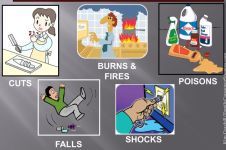Basic kitchen safety involves adhering to certain precautions and practices to prevent accidents and promote a safe cooking environment. To ensure kitchen safety, it is essential to maintain cleanliness and organization, utilize proper equipment and tools, handle food safely, and follow fire safety protocols.
Taking these preventive measures significantly reduces the risk of injuries, burns, foodborne illnesses, and fires in the kitchen. By prioritizing kitchen safety, individuals can enjoy cooking with peace of mind and protect themselves and others from potential hazards.

Credit: www.soulesinsurance.com
Importance Of Basic Kitchen Safety
Importance of basic kitchen safety: protect yourself and others by following basic kitchen safety guidelines. Prevent accidents and injuries by being cautious. To ensure safety, avoid foodborne illnesses by handling and storing food properly. Keep your kitchen clean and organized to minimize risks.
By implementing good hygiene practices, you can protect yourself and your loved ones. Remember to wash your hands frequently and maintain a clean working area. Stay aware of potential hazards such as hot surfaces, sharp knives, and electrical appliances. By practicing basic kitchen safety, you can create a safe and healthy environment for everyone.
So prioritize safety in the kitchen and reduce the chances of accidents and foodborne illnesses for a worry-free cooking experience.
Key Kitchen Hazards
Key kitchen hazards include slips, trips, and falls; burns and scalds; cuts and lacerations; and electrical accidents. To prevent accidents, keep floors dry and free of clutter. Use oven mitts and handle hot items with care. Use sharp knives cautiously and keep them stored safely.
Avoid frayed cords and damaged appliances, and unplug equipment when not in use.
Essential Kitchen Safety Tips
Basic kitchen safety is crucial for a smooth cooking experience. To start, keep floors clean and dry to prevent slipping hazards. Remember to use oven mitts and pot holders when handling hot cookware. Handle knives and sharp objects with utmost care to avoid accidental injuries.
Always remember to unplug appliances when they are not in use to reduce the risk of electrical accidents. Following these essential kitchen safety tips will help create a safe and enjoyable cooking environment.
Fire Safety In The Kitchen
Fire safety in the kitchen is crucial for basic kitchen safety. One essential aspect is installing and maintaining smoke alarms. It is also important to have a fire extinguisher within reach at all times. Never leave cooking unattended to prevent any potential fire hazards.
Additionally, keep flammable materials away from heat sources to avoid any accidents. Following these guidelines is necessary to ensure a safe and secure kitchen environment. Remember to prioritize fire safety to protect yourself and your loved ones from any untoward incident.
Food Safety Practices
Basic kitchen safety practices include washing hands before and after handling food. Separate raw and cooked food to prevent cross-contamination. Ensure proper storage and refrigeration of food to maintain freshness and prevent spoilage. Cook food thoroughly to eliminate harmful bacteria and ensure it is safe for consumption.
By following these guidelines, you can ensure a safe and healthy kitchen environment for yourself and your loved ones. Remember, food safety is essential for good health and well-being.
Creating A Safe Kitchen Environment
Creating a safe kitchen environment is crucial for basic kitchen safety. To start, organize and declutter countertops and cabinets to minimize hazards. Next, childproof the kitchen to ensure the safety of children. Adequate lighting is important to prevent accidents and provide clear visibility.
Additionally, keep cleaning supplies locked away to prevent accidental ingestion or harm. By following these guidelines, you can create a safe and functional kitchen space.
Frequently Asked Questions Of What Is Basic Kitchen Safety?
What Are The Basic Kitchen Safety Guidelines?
Basic kitchen safety guidelines include keeping knives away from the edge of the counter, not leaving cooking food unattended, and ensuring proper ventilation while using gas stoves. It’s also important to properly handle hot pots and pans and keep appliances away from water sources.
What Are The Common Kitchen Safety Hazards?
Common kitchen safety hazards include knife accidents, burns from hot surfaces or liquids, slips and falls due to wet floors, and electrical shock from faulty appliances. Food contamination is another hazard to watch out for, as it can lead to foodborne illnesses.
How Can I Prevent Kitchen Fires?
To prevent kitchen fires, always stay in the kitchen when cooking and keep an eye on the stove. Avoid leaving flammable items such as dish towels or oven mitts near heat sources. Regularly clean the oven and stove to remove grease buildup, and make sure to install and maintain a smoke detector in the kitchen.
Conclusion
Maintaining basic kitchen safety is crucial for both novice and experienced cooks alike. By following the guidelines outlined in this blog post, such as cleaning up spills immediately, properly storing and handling food, and using kitchen appliances safely, you can significantly reduce the risk of accidents and injuries in the kitchen.
Additionally, being aware of potential hazards, such as hot surfaces and sharp knives, can further enhance kitchen safety. Remember, a well-organized kitchen with clearly designated cooking and prep areas can also help prevent accidents. By prioritizing kitchen safety, you not only protect yourself and your loved ones, but also create an enjoyable and stress-free cooking environment.
So, put these kitchen safety practices into action and cook with confidence!

Leave a Reply